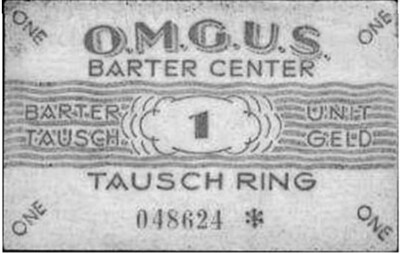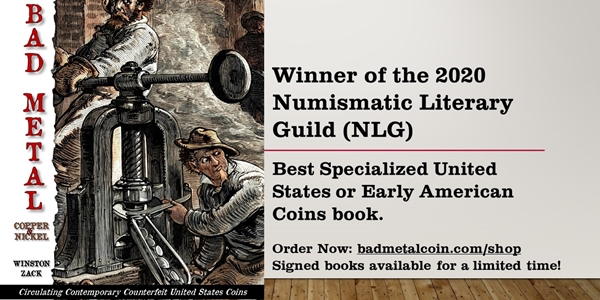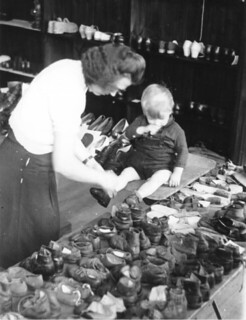
PREV ARTICLE
NEXT ARTICLE
FULL ISSUE
PREV FULL ISSUE
MORE ON GERMANY BARTER UNIT CERTIFICATESJP Koning writes: "I enjoyed the information about US-issued German barter scrip that you found. You got my curiosity going so I did some digging around. There is plenty more information about this scrip issuer in this paper. It begins on page 342, but the whole thing is interesting." JP attached Rolf F.H. Schroeder,"The Tausch-centers of the 1940s: closed markets as an alternative to the black economy" from the Journal of Historical Research in Marketing, 2015. -Editor
American–German barter-centers in Frankfurt (Main) and Berlin
This original design was based on the German model. All items were to be obtained from legitimate sources, transactions were supposed to be properly recorded and German experts were hired to appraise prices as prescribed by the Price Control Authority (Office of the Headquarters Commandant, 1946). This possibility to effectuate transactions between Germans and Americans became quite popular in Berlin, as well as in Frankfurt. The latter swap-shop employed more than 100 people. The Bremen newspaper Weser-Kurier (1947) described it as the "shop of a thousand wishes". There was a wide range in terms of both scope and quality of goods. Germans offered valuable used goods and received in return, among other things, durable packaged food or soap. Davis (1967, p. 153) describes how mail-order companies in the USA quickly reacted to the new demand by military personnel in Germany, and forwarded coffee, sugar, clothing items, etc., "usually in packages of ten cartons". In return, Americans got, for instance, Meißen porcelain or a camera – Leicas, in particular, were high in demand (Der Spiegel, 1947). To cope with the demand, price-fixing departed from the standard used in Tausch-centers and tokens were used to simplify trading. This success was also due to the fact that Americans could also sell cigarettes at these barter-centers. Because cigarettes had become the major currency on the black market, this was subject to controversial discussions within the US military administration. The issue was also debated by high-profile leaders of the US forces. 
Many Germans were quite discontented with these barter-centers. An activist of the Tausch-ring movement in Wuerttemberg-Baden commented critically that they represented "the selling off of German bourgeois affluence and the last residues of ownership to America" (Anon, 1946, "Besichtigung der amerikanischen Tauschzentrale in Frankfurt"). This view was shared by some Americans. In a magazine article published in June 1947, Bratter (1947, p. 42) writes that "the Barter Center has failed as an attack on the black market. Rather it fed the black market". He justifies this with the close parity of values at the barter-center and the black market. "On the black market, 25 cartons of cigarettes will buy a Leica camera; at the Barter Center, 23 cartons"
To read the complete paper (login required), see:
Loren Gatch writes: "About ten years ago I wrote an article on that very topic in Paper Money". Loren's article "From Black Market to Barter Mart in Postwar Germany" was published in the September/October 2011 issue of the journal of the Society of Paper Money Collectors. Here's an excerpt. BUTEs are "Barter Unit Certificates". -Editor If they did not end the black market, the Berlin and Frankfurt Barter Marts did bring some transactions out into the open and placed some limits on the exploitation of the civilian population. At the very least, the setup of the Barter Marts brought both legality, and perhaps a little dignity, to the black market experience. Of the two, the Frankfurt store became the more important one because of its location in the western sector. Housed in a vacant store space at Kaiserstraße 48-50 (at the corner of Weserstraße) a few blocks from the train station, the Frankfurt Barter Mart operated on two floors. German civilians, who formed long lines outside beginning early in the morning, brought their heirlooms and antiques up to the second floor. There, a team of German appraisers, supervised by American officers, assigned points to each item. These points converted into paper BUTEs that the Germans could use to purchase vital commodities, deposited by the Americans, on the first floor. BUTE prices at the Frankfurt Barter Mart could not be substantially out of line with the black market generally, since too great of a divergence would drive barter transactions off the premises. In any event, daily turnover was as high as 85%, and the store quickly became the major shopping center in the American and British zones. Special trains were even engaged during the holiday season to bring eager Germans to Frankfurt for shopping at the Barter Mart. The valuation of the items was left to German appraisers, who assigned a value in BUTEs to whatever item their countrymen brought in. Naturally, the suspicion arose that German appraisers favored their own against the Americans. Yet, in this fantastic world where a single carton of cigarettes bartered for many times the weekly wage of a German worker, it would have been hard to object to any particular valuation. Beyond providing some regularity to black market pricing, both Barter Marts served the important purpose of physically separating the Americans and the Germans. Nonetheless, the American authorities were sensitive to the perception that the Barter Marts amounted to official recognition of exploitation by a conquering power, and looked forward to their closure. In early January 1948, Clay announced the Berlin and Frankfurt barter centers would accept no more goods after April 1, and would close on the first of May. Outstanding scrip would become valueless at that time. The inventories in both locations were liquidated in a vast close-out sale that brought out to the Frankfurt location alone 2,500 customers, mostly army wives, who cleaned out most of the remaining inventory in exchange for military scrip rated at 5 cents a BUTE. Proceeds from these sales, and from a final lottery to dispose of remainders, amounted to some $38,000 and was turned over to the German Youth Activities group. One series is known for the OMGUS Barter Center in Berlin, in the denominations of 1-, 5-, 10-, 25-, 50-, and 100-"Barter Units" (though Schwan and Boling report only the 1- and 5- denominations extant (SB nos. 601-606). 
1 Barter Unit (SB 601) Four main varieties of "Barter Unit Certificates" (BUTEs) were printed for the Headquarters Command Barter Center in Frankfurt. The first variety consisted of the series of 1946 and 1947 and differed only by the date, and the color of the 50-BUTE note (SB nos. 611-622). These also appeared in denominations of 1, 5-, 10-, 25-, 50- and 100-BUTEs. 
The former Frankfurt Barter Center as it appears today. Thanks, everyone! Great information. See Loren's article for more images and information about the notes. -Editor
To read the earlier E-Sylum article, see:

Wayne Homren, Editor The Numismatic Bibliomania Society is a non-profit organization promoting numismatic literature. See our web site at coinbooks.org. To submit items for publication in The E-Sylum, write to the Editor at this address: whomren@gmail.com To subscribe go to: https://my.binhost.com/lists/listinfo/esylum All Rights Reserved. NBS Home Page Contact the NBS webmaster 
|
